![[*]](http://sepwww.stanford.edu/latex2html/prev_gr.gif)
ABSTRACTSatellite measurements from the Southwest Indian Ridge provide information about the local ocean topography along both ascending and descending tracks. We present a weighted least-squares approach to combine the information given along these two measurement directions, thus obtaining a dense altitude coverage. High-frequency, spiky noise along the tracks is eliminated by additional weighting of the derivatives of the initial residuals. After having obtained the optimal altitude fit to the crossing data, we illuminate the local seafloor features using a set of first-order derivative filters. The results show high image resolution, indicating effective noise removal. |
INTRODUCTION
Information about global ocean topography can be inferred from advanced radar altimetry measurements of earth satellites. These satellites orbit around the earth in north-flying and south-flying tracks which appear to drift westward due to the earth's rotation. They measure both the rather high-frequency seafloor topography and the low-frequency sea surface altitude which is influenced by weather changes, tides and ocean currents at the time of the recording. The high-frequency seafloor component can be separated from the masking low-frequency trend by taking the time derivative along the tracks. In order to obtain an optimal altitude coverage of a specific area, the measurements along those two non-orthogonal satellite track directions must be combined. This approach might be directly applicable to the frequently occurring problem of tying inconsistent seismic lines to obtain higher information density for 3-D surveys.
In this paper, we present a weighted least-squares approach to combine track measurements from the Southwest Indian Ridge in the Indian Ocean. The method is based on an approach proposed by Claerbout . The weighting function which is applied to each track is represented by a derivative operator along the tracks to eliminate the low-frequency data trend. Failure to remove this component would cause large residuals for the least-squares fitting of crossing tracks that are inconsistent at the crossing point. Since the data appear to be contaminated by high-frequency, spiky noise, we additionally weight the derivative of the starting residuals. Subsequently, we convolve the resulting altitude data with a set of first order derivative filters in different directions to illuminate the local features.
SATELLITE DATA
The data consist of two sets of altimetry measurements recorded by the
satellite GEOSAT above parts of the Southwest Indian Ridge in the
Indian Ocean.
The two data sets correspond to the ascending and descending paths
of the satellite, thus representing two crossing track data sets.
Both ascending and descending tracks have a spatial interval of
approximately 2.8 km and cover an area between latitude ![]() and
and ![]() and longitude
and longitude ![]() and
and ![]() .A gravity anomaly map of the Indian Ocean, which was given to us by
Professor David Sandwell, University of California in San Diego,
(Figure map) displays
the interesting seafloor topography in this region. The part of the
Southwest Indian Ridge structure covered by the satellite measurements
is indicated by the small rectangular area. Both the ascending and the
descending data files consist of seven columns of 32 bit integers each of
which include more than 220,000 measurements. The columns correspond
to the following parameters:
.A gravity anomaly map of the Indian Ocean, which was given to us by
Professor David Sandwell, University of California in San Diego,
(Figure map) displays
the interesting seafloor topography in this region. The part of the
Southwest Indian Ridge structure covered by the satellite measurements
is indicated by the small rectangular area. Both the ascending and the
descending data files consist of seven columns of 32 bit integers each of
which include more than 220,000 measurements. The columns correspond
to the following parameters:
 |
Figure tracks shows the altitude data for both the ascending and
descending satellite tracks which were interpolated to a regular grid
of 100 points along the vertical axis and 240 points along the horizontal
axis. Although the single tracks can be clearly discriminated, the coverage
of the ridge region is relatively dense in both directions. The recorded data
corresponds to the height difference between the sea surface and the
reference ellipsoid at the respective locations. Regions of high relief are
plotted as white, while regions of low relief appear dark.
The gravitational attraction of sea mountains, trenches and ridges beneath the
sea causes the sea surface altitude to vary globally, thus mirroring the
seafloor topography. However, in Figure tracks the seafloor features
are not visible. They are masked by a low-frequency trend
of the sea surface altitude induced by changes in weather, tides and
ocean currents.
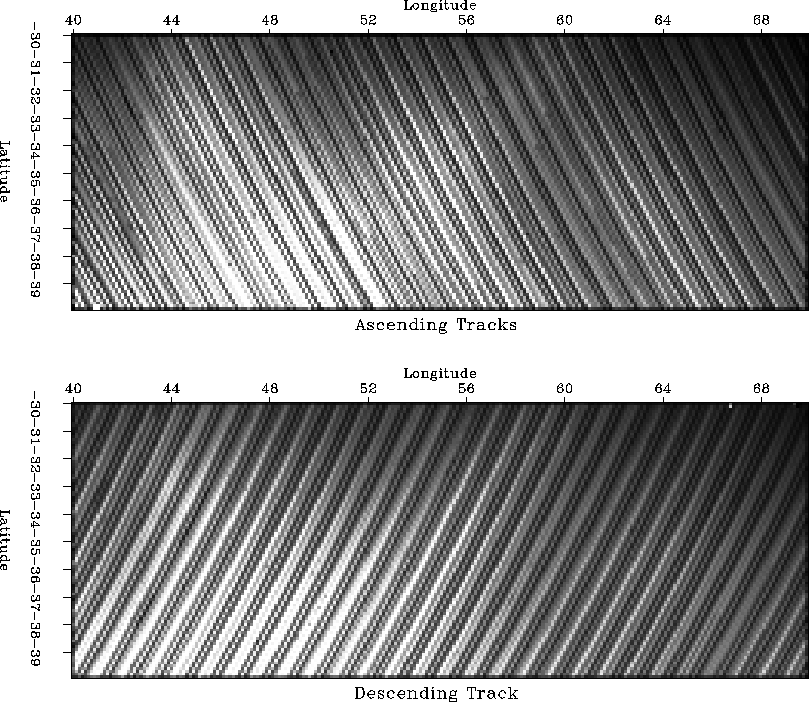 |
COMBINATION OF THE TRACKS
In order to obtain higher information density/data coverage in the region covered by the satellite measurements, we attempt to combine the data information given along the ascending and descending tracks. This is accomplished using a weighted least-squares approach as described by Claerbout . In this approach, we use conjugate gradients to find the best-fitting altitude h mapped on a regular grid by combining the two irregularly-sampled data vectors da (ascending tracks) and dd (descending tracks). The following equations describe the problem formulation:
| (1) |
| (2) |
where ![]() is the derivative along the
ascending tracks and
is the derivative along the
ascending tracks and ![]() is the
derivative along the descending tracks; ra is the ascending
residual, while rd is the descending residual.
The linear interpolation operators La and Ld
put the data on a regular grid.
is the
derivative along the descending tracks; ra is the ascending
residual, while rd is the descending residual.
The linear interpolation operators La and Ld
put the data on a regular grid.
The derivative operators correspond to weighting operators along the data recording trajectories. They remove the low-frequency data trend caused by tides or ocean currents. Failure to account for this trend would result in significantly large residuals for the fitting of crossing tracks that are inconsistent at the point of crossing.
In order to obtain an optimal altitude h, we must
eliminate the high-frequency, spiky noise that appears to contaminate the
data. Since the noise is more prominent after the derivative is
applied along each track, we attempt to remove it by weighting the
initial ascending and descending residuals ra0 and rd0.
Since the noise spikes are easy to identify in these data, we apply a
weighting function which cuts off all energy bursts above a mean value
![]() .
.
| (3) |
| (4) |
| (5) |
Figure iter shows the optimal altitude h after 10, 100 and 5000 iterations. After only 10 iterations, the altitude displays none of the low-frequency behavior of the original data. It is rather characterized by high-frequency features resembling a ridge structure as shown in the gravity anomaly map (Figure map). This is due to the fact that we use the derivatives along the tracks as weighting operators. They eliminate the low-frequencies in the data, thus minimizing the possible inconsistencies between crossing data points. Therefore, if too few iterations are applied, the low-frequency trend of the original data will not be recreated. The more iterations are incorporated into the least-squares fitting, the more low-frequencies are included into the solution altitude. After 100 iterations, the ridge structure has considerably faded, and after 5000 iterations the altitude represents a good fit to the original ascending and descending data shown in Figure tracks.
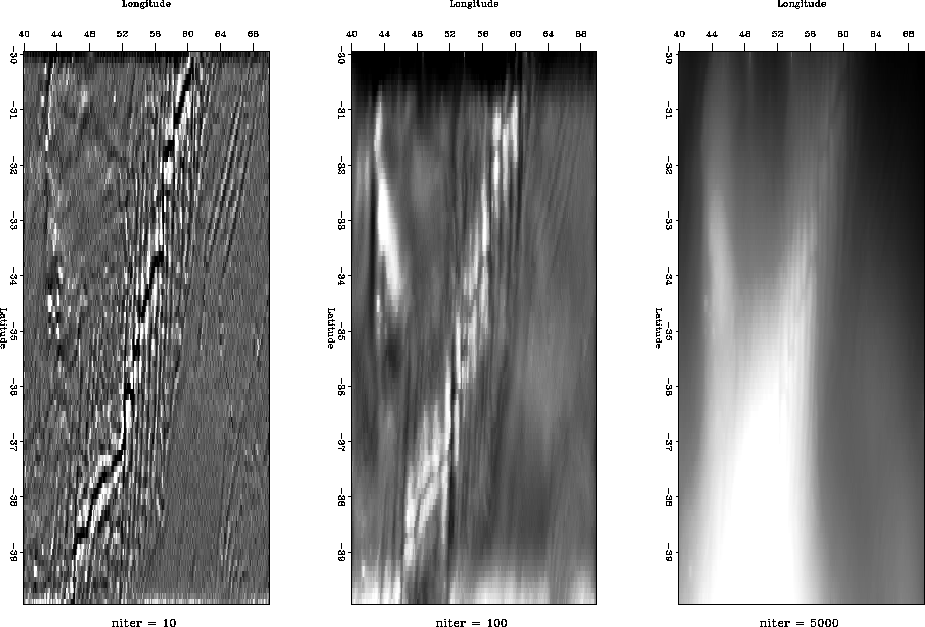 |
ILLUMINATION OF THE ALTITUDE DATA
After having combined the altitude information given by both the
ascending and descending satellite measurements, we attempt to derive
an image of the local seafloor topography from the new altitude data.
Since the topography information is masked by a low-frequency
trend, we convolve the data with a set of first-order derivatives to
illuminate the seafloor features. These four filters consist of a vertical
filter, a horizontal filter and two diagonal filters. One is taken at
![]() which is approximate in direction of the
ascending tracks, while the other one
runs at
which is approximate in direction of the
ascending tracks, while the other one
runs at ![]() in approximately the direction of the descending tracks.
The filters are
represented by:
in approximately the direction of the descending tracks.
The filters are
represented by:
![]() ,
,![]() ,
,![]() ,
,![]()
Figure asc-deriv shows the illumination of
the seafloor in the direction of
the ascending tracks. The upper frame is the result of taking the derivative
along the original ascending data tracks. The single tracks are clearly visible,
as well as some scattered noise bursts. A ridge structure strikes diagonal
from SW to NE and seems to be translated by several N-S striking transform
faults. To the west of the ridge, a small topographic feature is
noticeable, but quite difficult to recognize. The lower frame of
Figure asc-deriv represents the result of the convolution of the
solution altitude h
with a diagonal filter in the direction of
the ascending tracks. Although the original track direction is not exactly
![]() , it can be considered a good approximation. It is obvious
that the use of the solution altitude results in a significantly increase
of the image resolution. The combination of the ascending and
descending data has improved the data quality, as well as effectively
removed the noise spikes. It is easy to identify both the transform faults
translating the ridge structure and the sea mountain west of the ridge.
, it can be considered a good approximation. It is obvious
that the use of the solution altitude results in a significantly increase
of the image resolution. The combination of the ascending and
descending data has improved the data quality, as well as effectively
removed the noise spikes. It is easy to identify both the transform faults
translating the ridge structure and the sea mountain west of the ridge.
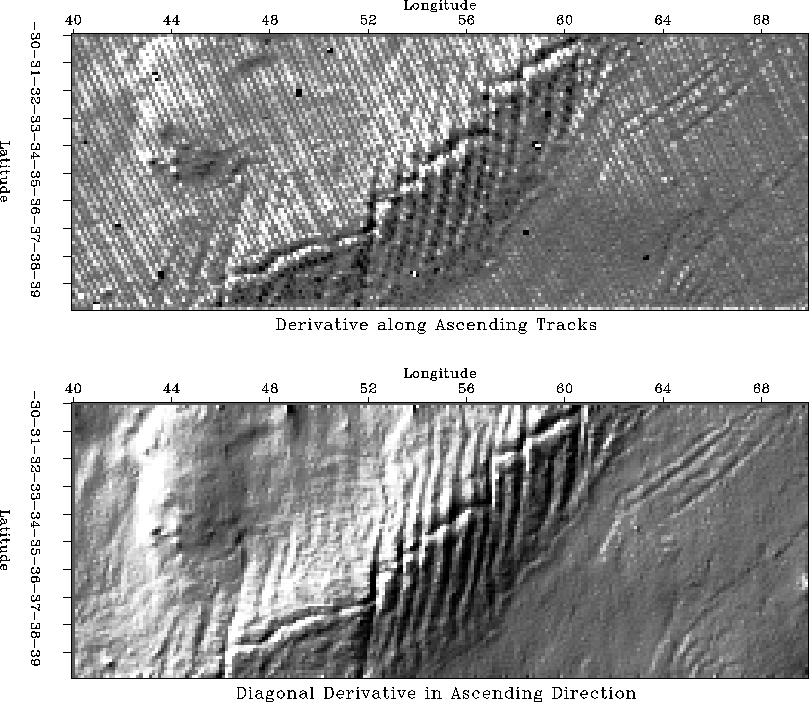 |
Figure desc-deriv displays the illumination of the seafloor in the direction of the descending tracks. As before, the upper frame represents the derivative taken along the tracks of the original descending data set. The lower frame illuminates the seafloor of the altitude data after combining ascending and descending data. Like the illumination in the ascending direction, this Figure shows the improvement in image quality and resolution of the data combination over the original data set. It also indicates the successful elimination of noise bursts in the data. As a result of the use of a filter in the descending direction, the actual ridge structure appears much dimmer than in Figure asc-deriv and is characterized by less relief. The most prominent features are the N-S striking transform faults. The westward sea mountain, illuminated from the opposite side than before, is also obvious.
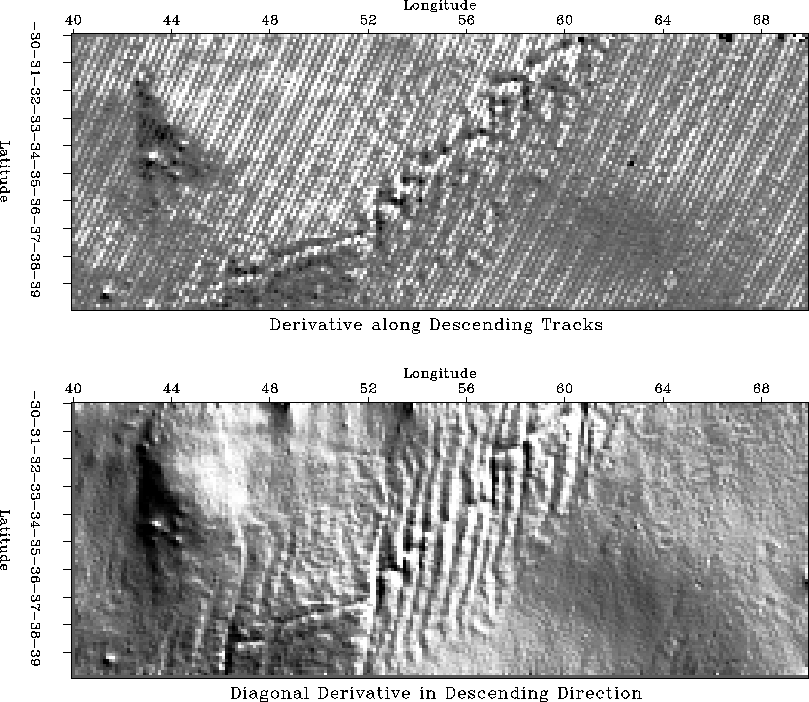 |
Figure deriv shows the result of the illumination of the seafloor features using a horizontal and a vertical filter. Both filters were convolved with the solution altitude h after combining the ascending and descending data set. As in the illumination with a diagonal filter in the descending direction, convolution with a horizontal filter does not show much of the ridge structure itself, but results in proment N-S striking transform faults. The illumination using a vertical filter, on the other hand, clearly accentuates the ridge structure and suppresses the transform faults entirely. Contrary to the horizontal filter, the vertical filter displays less ``shadow zones''.
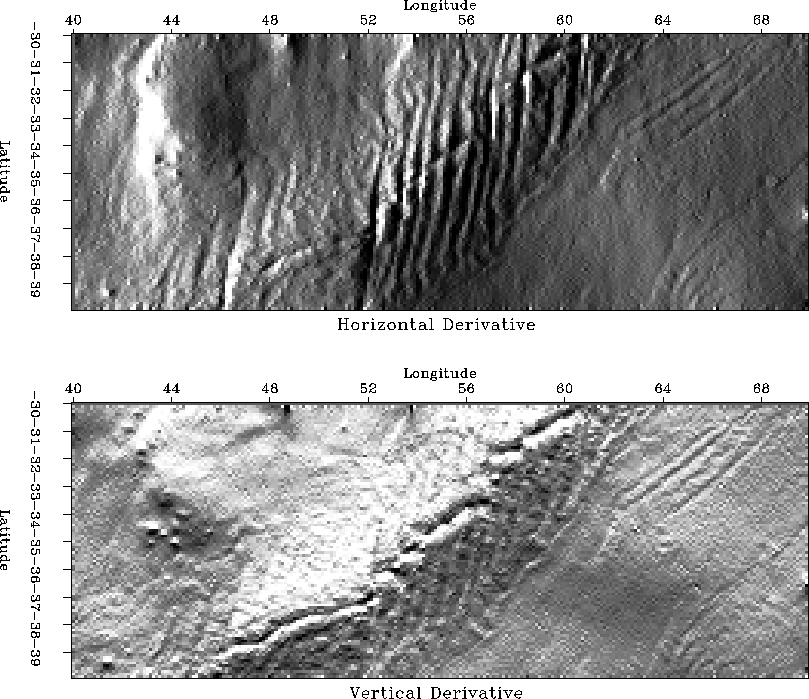 |
FUTURE RESEARCH
Besides the two data sets presented in this paper, we are in the
possession of two more data sets which cover the area
between latitude ![]() and
and ![]() and longitude
and longitude ![]() and
and ![]() . These
two data sets are directly adjacent to those shown her and also consist
of ascending and descending satellite track measurements. However,
their spatial sampling interval between tracks is considerably larger,
thus resulting in a relatively sparse coverage of the region.
. These
two data sets are directly adjacent to those shown her and also consist
of ascending and descending satellite track measurements. However,
their spatial sampling interval between tracks is considerably larger,
thus resulting in a relatively sparse coverage of the region.
As a future research opportunity, it might be interesting to try to determine the missing information in these data sets. One possibility might be the determination of a 2-D prediction error filter in the already known region defined by the data sets that were combined in this study. This PEF might then be applied to the combined, sparse data tracks. In this case, a region of dense coverage would be used to obtain information about a region of sparse data coverage. Another possibility might be to recreate the data by using two 1-D prediction error filters determined directly along each track, as proposed by Jon Claerbout in his book Three-Dimensional Filtering. In this case, a dense coverage of a region would not be necessary.
CONCLUSIONS
Ascending and descending satellite measurements above part of the Southwest Indian Ridge were used to demonstrate a weighted least-squares technique to combine the given data information. This was done to obtain a higher information density and thus an optimal data coverage. The problem of high-frequency, spiky noise contamination in both data sets was solved by applying an initial weighting function to the starting residuals. Our results show that the combination of the two data sets resulted in an considerable increase of image resolution. The dat quality improved significantly and the noise burst could be effectively removed.
ACKNOWLEDGEMENTS
We would like to thank Professor Jon Claerbout for his valuable ideas and advise. We also thank Professor David Sandwell, the University of California in San Diego, for providing Professor Claerbout with the Seasat dataset.
[MISC,SEP]
![[*]](http://sepwww.stanford.edu/latex2html/prev_gr.gif)